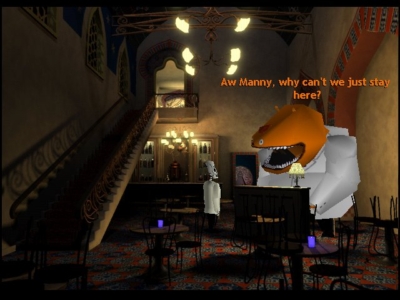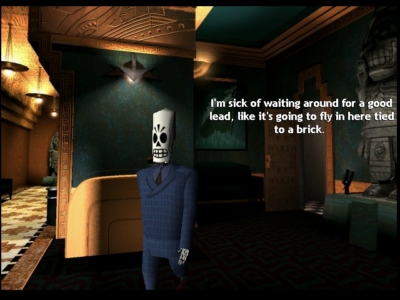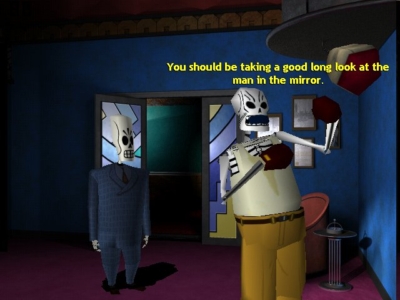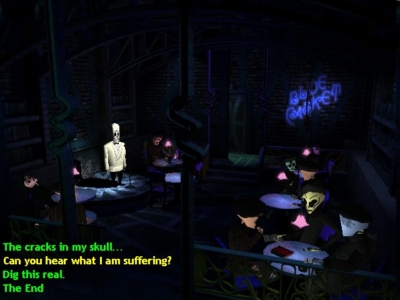
Grim Fandango
Written by: Rik
Date posted: August 27, 2009
- Genre: Adventure
- Developed by: LucasArts
- Published by: LucasArts
- Year released: 1998
- Our score: 9
Despite supposedly being a fan of adventure games, particularly those from the LucasArts stable, I’ve somehow managed to ignore Grim Fandango over the past 11 years. This isn’t the whoops-how-did-that-happen kind of ignorance, either, in case you’re imagining a scenario where I never got around to buying it when first released, then found it had disappeared from the shops (which it has, by and large) and then experienced extreme difficulty in sourcing a reasonably-priced second hand copy. That, you could kind of understand. Instead, though, it’s the kind where I see and buy a copy but then leave it in my cupboard for 18 months, ignoring it even though it was right there every time I thought about playing a game.
To anyone who’s played, and enjoyed, Grim Fandango – as I now have, finally, so I include myself in this – these are clearly the actions of a moron, because this is one of the finest adventure games ever created, up there with the very best that LucasArts have produced. If, like me, you’ve somehow omitted to play it, then I advise that you rectify this situation as soon as is humanly possible. Whatever reservations you have about the game, you’ll soon cast them aside and then, later, ridicule yourself for having them in the first place.
But when you get to this stage, don’t be too hard on yourself. I mean, you can ridicule yourself a little bit, but, you know, don’t go too crazy. Because whatever vague combination of half-reasons persuaded you that you weren’t missing out on much (my own were: “the back of the box doesn’t make it sound that good” and “I couldn’t get the demo to work in 1998”) you can be reassured that plenty of other people felt the same. Despite healthy critical acclaim, Grim didn’t sell too well, or not as well as LucasArts might have liked, and it ended up being their penultimate adventure release (the last being Escape from Monkey Island). We could speculate on whether the poor retail performance of Grim contributed to the general conviction that the adventure game was “dead” or that the death of the genre meant that people overlooked this game, but we won’t bother.
Instead, let’s talk about Grim Fandango itself, which is set, funnily enough, in the Land of the Dead, a place where souls reside during their four-year journey to eternal rest. Our hero is Manny Calavera, a soul who has a debt to pay for things he did while he was alive, and for whom salvation must wait until that debt is paid off. To do so, Manny works as a travel agent at the Department of Death, picking up souls from the land of the living and selling them a travel package to get them through their four-year journey in as great a comfort as they can afford. Recently, though, Manny seems to be out of luck when it comes to the clients that come his way – they don’t qualify for anything that pays commission. Desperate to catch a break, Manny uncovers a conspiracy which, as ever, gets him in deeper trouble than he thought possible.
While such a set-up doesn’t exactly represent a major sea-change from the usual LucasArts fare, Grim Fandango nevertheless sets itself aside from its point-and-click predecessors. While it’s definitely a funny game, it’s definitely not from the same stable of wacky cartoonishness as the likes of Sam and Max and Day of the Tentacle. Likewise, anyone expecting the usual Star Wars or Indiana Jones references to crop up is likely to be disappointed, there aren’t any portraits or statues of Max the rabbit lurking about, and no-one is going to invite you to ask them about Loom TM.
Beyond that, the style of the game is fairly distinctive. Aside from the fact that most characters are dead and resemble skeletons, there’s a 1930s feel to the game world. Apart from noting that I quite liked it all, and that there was a certain film noir flavour to certain sections of the game, I thought nothing more about this until some I did a bit of internet “research” and found some rather detailed prattle about the art-deco design of the buildings and the numerous references to specific films from the film noir genre. Oh, and the fact that the whole concept of the Land of the Dead and the four-year journey to eternal rest, has its roots in Aztec beliefs (although I later found that this was mentioned in the game manual as well).
While it’s certainly interesting to make a little note of, the fact is that prior knowledge of any of this kind of stuff makes no difference to whether you enjoy the game or not, and even mentioning it at all makes the game sound pretentious when it isn’t. Frankly, if it all sounds a little off-putting, it’s probably best to put it out of your mind altogether, and at least be reassured by the fact that the terms “art-deco”, “film noir” and “Aztec beliefs” mean about as much to me now as they did before I started playing the game – ie, nothing.
And I wasn’t trying to insult the likes of Sam and Max and Day of the Tentacle when I called them cartoonish, either – I really like those games. All you really need to know is that you need to expect a subtle, but discernable, change in tone when you approach this game. The humour is there, but it’s drier and darker than before. The characters are more than loveable puppets who spout witty dialogue on demand – you actually care what happens to them. It’s a funny game, yes, but it’s also an involving and (dare I say it) touching one at times.
Or, to put it another way, you might simply say that all of the staples of good adventuring are present and correct in this game. It’s well presented, with the combination of 2D backgrounds and 3D characters blending together nicely. Polygon characters, especially of this vintage, don’t always look convincing (by way of comparison, I didn’t think Escape from Monkey Island pulled this off so well – Guybrush looks like a blow-up doll in that game) but they do so here, aided by animation and direction that really brings the characters to life. In the sound department, the dialogue is sharp and delivered by some strong voice acting talent and backed up by excellent music throughout. The gameplay, meanwhile, is less reliant on the usual ‘use this on that’ inventory-based fare than on actual puzzles, including some real head-scratchers.
In fact, Grim Fandango is absolutely rock hard at times, and the less rationally minded may occasionally be moved to venture the opinion that the game has violated LucasArts tradition by leading you down a dead end from which there can be no possible return. Of course, this isn’t the case, although I do have to report one occasion when I did get impossibly stuck, thanks to a by-now quite well-known (although not by me) bug which can be fixed through patching, or by approaching the puzzle in question in a different way. Still, it’s one of the only times I’ve ever had such a problem with a LucasArts game, and it was bloody frustrating to say the least (especially as I hadn’t saved my game for a while).
On the theme of frustration, and general negativity, it’s also worth mentioning that there are one or two issues with the control system used in the game. Your character is no longer controlled through the trusty point and click of a mouse, and instead you have to use your joypad or keyboard to move around and interact with the game world. While movement is mostly fine, there are times when you just can’t seem to get Manny to go where you want him to go, most annoyingly when he heads through an exit or back into the room you’ve just left. Movement with keys does occasionally make getting from location to location a bit of a chore, too; a map screen allowing you to ‘jump’ to wherever you wanted to go might have been a good addition.
I also found the total absence of text from the interface a bit of a drawback. Although Manny draws your attention to items you can interact with by looking at them in the game world, there are easily things you can miss, and there did occasionally seem to be a problem establishing what he was looking at if two items were relatively close together. It never caused a major problem, but without sounding like a retro bore, the engine employed here seems to represent a step backwards from the old 2D system which did at least make clear what it was you were looking at and/or instructing your character to do.
In the general scheme of things, though, such niggles are relatively minor, and in no way detract from the overall quality of the game. As I’ve probably already made clear (not least from the number sitting at the top of the page), I think Grim Fandango is a great game. In fact, I’d go so far to say that I was genuinely surprised at how good it was, even allowing for the good things I’d heard and the fact that it was from LucasArts.

Your sidekick Glottis, a demon who exists only to drive. Luckily, he’s pretty handy on the piano, too. One of the best characters in the game, or in any game. Ever.
If, like me (and with apologies if it seems like I’m labouring the point here) [You are – FFG reader] you were also aware of these facts but somehow they haven’t been enough to persuade you to play the game, then I shall say this to you: Grim Fandango isn’t just another LucasArts adventure, it’s one of the best ones. It’s all of the things that you’d expect – witty, clever, and slickly produced – but it’s also some things you may not. You care about what happens in the story, and to the characters. Look, I even shed a tear at one point, goddammit! What more do you want?
On the other hand, in my haste to recommend the game, it could well be that I’ve somehow made it sound like it’s so different from what’s gone before that it actually doesn’t appeal to you. And so, to you I say: Grim Fandango is just another comedy adventure in the LucasArts tradition. Forget all that stuff about art deco blah-de-blah and the bit where I said I cried – I was lying. If you intend to plough through all of the LucasArts adventures, make sure you include this one – it’s like all the others, and just as good.





 Posts
Posts
Grim Gandango is now available on GOG.com, a remastered edition for newer OS’ that has point-and-click interface, alongside with the original, tank-based!
I have a second hand copy for XP, but it refused to work every time I attempted to give it a spin, so I had to wait up until the upgrade to Win 7, to be able to get it from GOG and enjoy it as I did in early 00’s.
Truly, it’s a great game! And this comes from a person that generally doesn’t like andventure games!
June 9, 2017 @ 10:25 pm
Hi Oleg. Thanks for the reminder – I picked up the remastered version in a GOG sale a while ago, but haven’t got around to trying it yet.
June 11, 2017 @ 1:52 pm